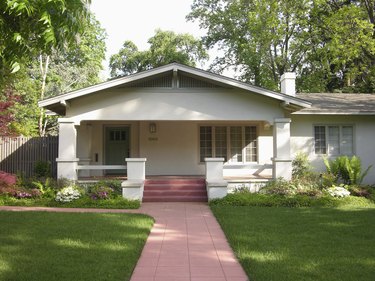
Siding can in fact be put over stucco, but there is a lot of prep work involved, such as repairing cracks, screwing furring strips to the stucco, and insulating the exterior of your home. These are all steps that need to be taken long before the first piece of siding is attached to the home's exterior.
Some siding types require even more steps, but the end result, no matter which type of siding you choose, can give you a long-lasting, energy-efficient, modern exterior that will last for decades.
Video of the Day
Video of the Day
Repairing Cracks in the Stucco
It may seem silly to repair cracks in something you are just going to cover up, but it is a necessary step. Making any necessary repairs caused by moisture is the first step in the process of putting siding over stucco. While making repairs, don't worry too much about appearance because it will all be covered by the end product. The key to this step is to ensure that the stucco is moisture-proof.
Install Furring Strips
Whichever siding you decide to use, it will need to attach every 16 inches. Use pressure-treated 2x4s around windows, doors, and corners, adding them vertically as well, every 16 inches. Stucco is primarily a masonry product which collects moisture; this moisture will be absorbed into the furring strips which will rot if untreated. Therefore pressure-treated wood is necessary.
- Cut 2x4 boards to the length as needed.
- Predrill holes in pressure-treated wood for masonry screws every 8 inches. You will be attaching them on the 2-inch side of the furring strip, which in reality is 1 1/2 inches.
- While holding the furring strip in place, drill the holes into the stucco to match the pre-drilled holes in the furring strip. You may need to use a hammer drill and masonry bit sized properly for the masonry screws. Keep in mind that any seams where two ends of siding meet must be supported by a furring strip.
- Attach the boards with masonry screws and a screw gun.
- Continue the process over the entire area to be sided.
Insulate the Exterior
The furring strips are 1 1/2 inches thick as you attached them to the home's exterior, so the rigid foam insulation should also be 1 1/2 inches thick. This is where the energy savings part of the project can really come together.
- Cut the rigid foam insulation to fit snugly between the furring strips.
- Spread glue that is specific for stucco on the stucco or directly onto the insulation.
- Place the snugly cut section of insulation in place. Be sure it is tight to the stucco and the glue has made good contact.
- Continue insulating the rest of the structure.
Install the Siding
The steps for installing the siding vary based on the siding you choose for your project. For example, vinyl siding requires the installation of J-channel around windows as well as corner molding to secure the vinyl siding. Board and batten siding can be used following good installation techniques. No matter what siding you use, attach any trim around the windows, corners, and doors prior to installing the siding.
- Install all corner, window, and door trim.
- Working from bottom to top, attach the siding to the furring strips every 16 inches. Overlap each horizontal row.
- Cut siding around windows, doors, and walls making sure it is tight to the molding or J-channel, as is appropriate for your siding application.
Choosing the Right Siding for Your Home
Selecting siding to cover your stucco entails a few considerations, among them cost. Vinyl siding is the most budget friendly and will last for many years without too much concern. Metal siding also will last many years without issues but may need to be painted and can dent very easily. One siding that can stand the test of time is fiber cement siding which can last up to 50 years with little maintenance.